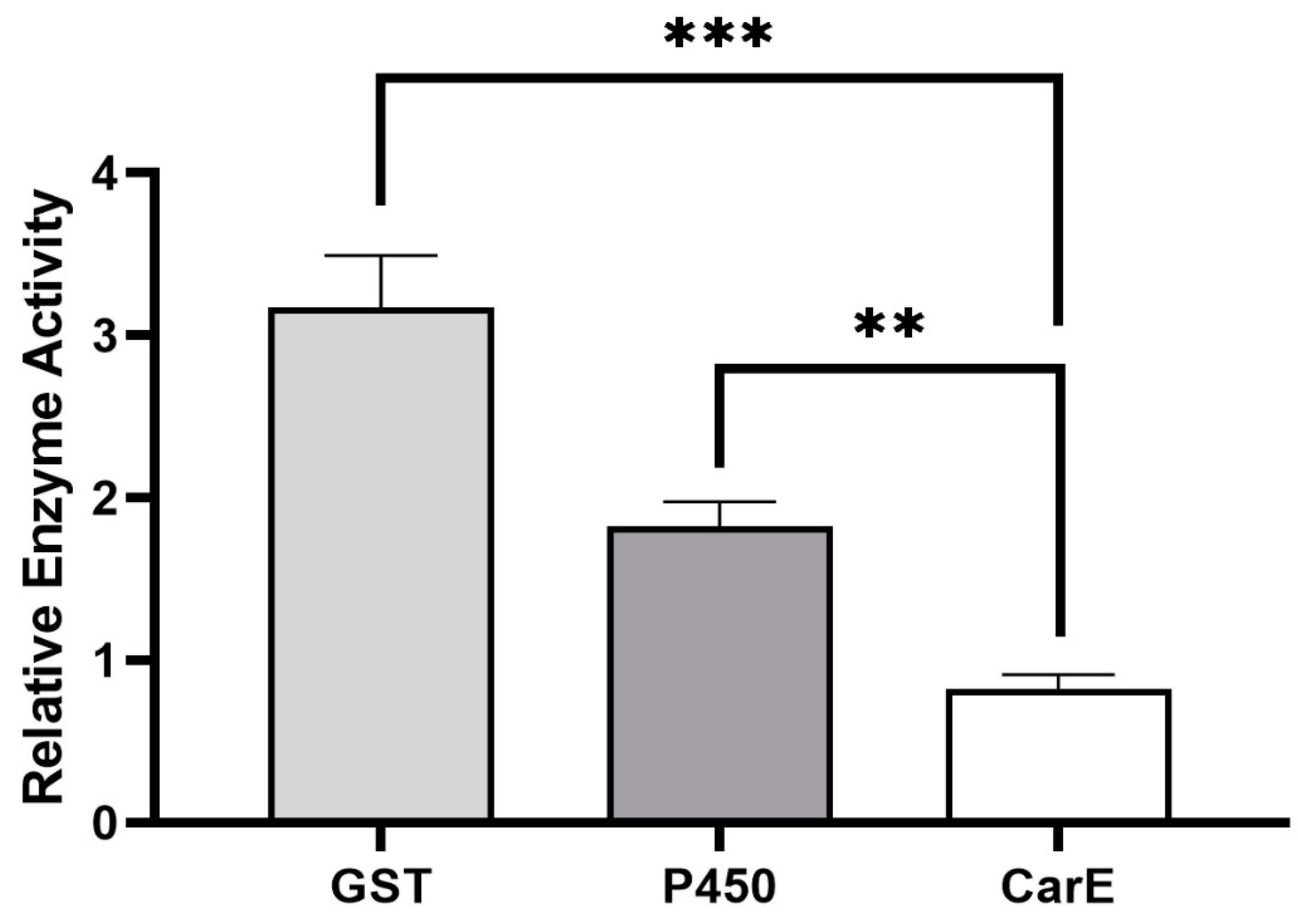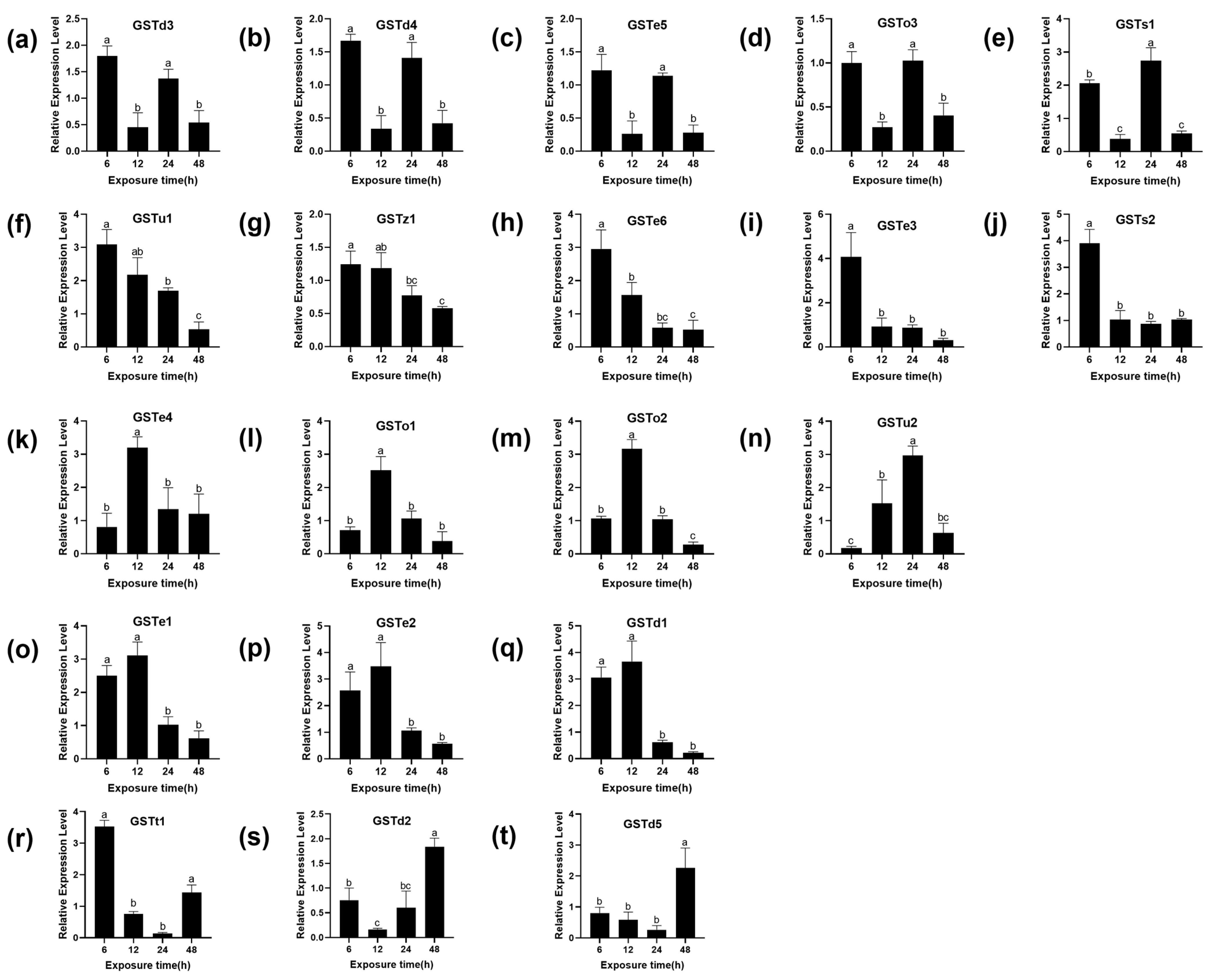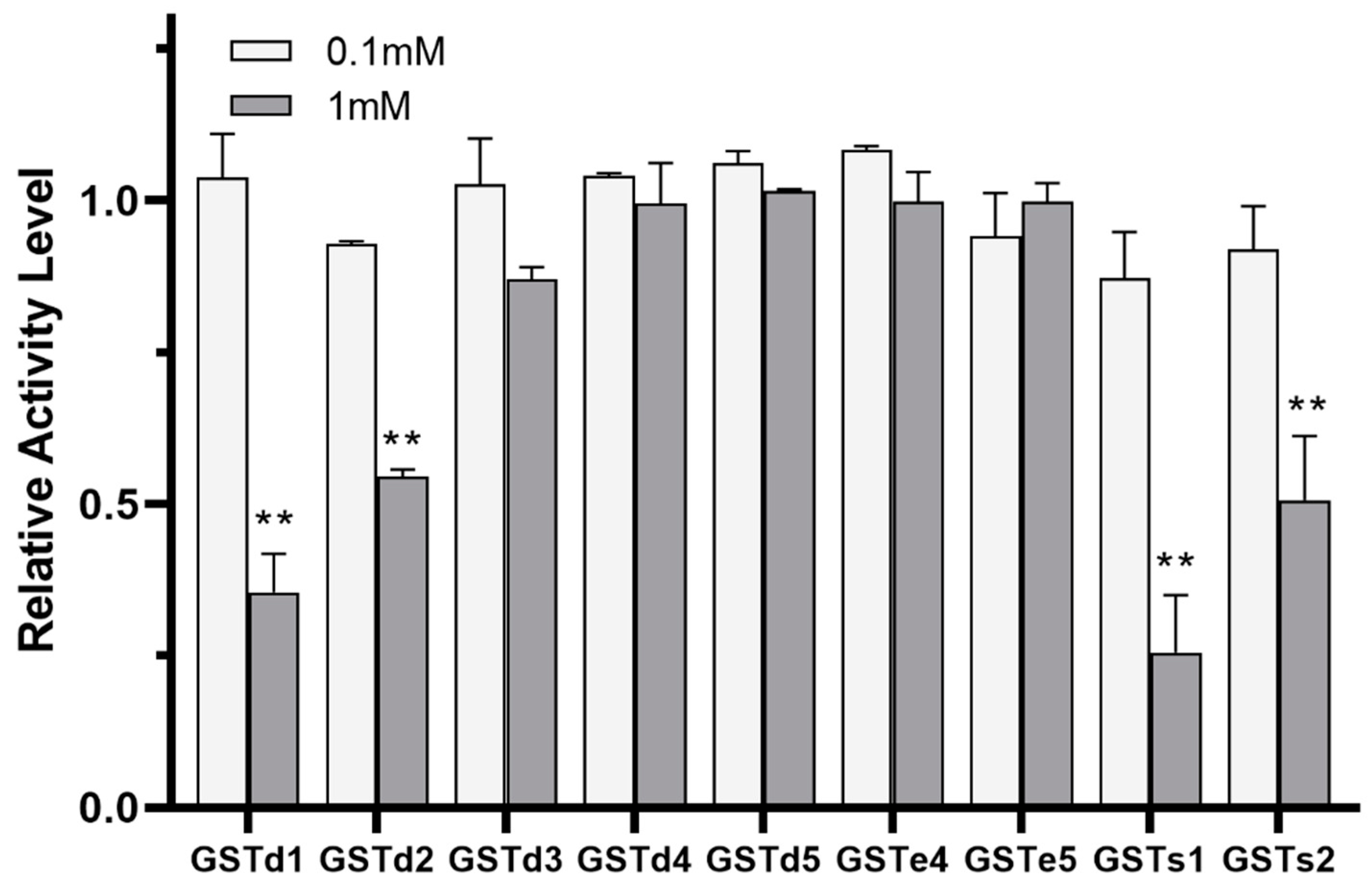Glutathione S-Transferase May Contribute to the Detoxification of (S)-(−)-Palasonin in Plutella xylostella (L.) via Direct Metabolism
Abstract
Simple Summary
Abstract
1. Introduction
2. Materials and Methods
2.1. Plutella xylostella
2.2. (S)-(−)-Palasonin Exposed
2.3. Enzyme Activity Assay
2.4. Quantitative Reverse Transcription Polymerase Chain Reaction (qRT-PCR)
2.5. Expression of the Plutella xylostella Recombinant GST Proteins (GSTs)
2.6. Enzymatic Activity and Inhibition Assays
2.7. Metabolism Assays
2.8. Statistical Analysis
3. Results and Discussion
3.1. Activity Changes of Detoxifying Enzymes in Field Strain of Plutella xylostella
3.2. GST Activity
3.3. Expression Levels Effect of GSTs Exposure to (S)-(−)-Palasonin
3.4. Recombinant Protein Expression and Kinetics of GSTs
3.5. Inhibitory and Metabolism Effects between (S)-(−)-Palasonin and GSTs
4. Conclusions
Supplementary Materials
Author Contributions
Funding
Institutional Review Board Statement
Data Availability Statement
Acknowledgments
Conflicts of Interest
References
- Talekar, N.S.; Shelton, A.M. Biology, ecology, and management of the diamondback moth. Annu. Rev. Entomol. 1993, 38, 275–301. [Google Scholar] [CrossRef]
- Sarfraz, M.; Dosdall, L.M.; Keddie, B.A. Evidence for behavioural resistance by the diamondback moth, Plutella xylostella (L.). J. Appl. Entomol. 2005, 129, 340–341. [Google Scholar] [CrossRef]
- Liao, J.; Xue, Y.; Xiao, G.; Xie, M.; Huang, S.; You, S.; Wyckhuys, K.A.; You, M. Inheritance and fitness costs of resistance to Bacillus thuringiensis toxin Cry2Ad in laboratory strains of the diamondback moth, Plutella xylostella (L.). Sci. Rep. 2019, 9, 6113. [Google Scholar] [CrossRef] [PubMed]
- Wang, X.; Wu, Y. High levels of resistance to chlorantraniliprole evolved in field populations of Plutella xylostella. J. Econ. Entom. 2012, 105, 1019–1023. [Google Scholar] [CrossRef]
- Loc, N.T.; Chi, V.T.B. Biocontrol potential of Metarhizium anisopliae and Beauveria bassiana against diamondback moth, Plutella xylostella. Omonrice 2007, 15, 86–93. [Google Scholar]
- Mohan, M.; Gujar, G. Local variation in susceptibility of the diamondback moth, Plutella xylostella (Linnaeus) to insecticides and role of detoxification enzymes. Crop Prot. 2003, 22, 495–504. [Google Scholar] [CrossRef]
- Saini, P.; Gopal, M.; Kumar, R.; Gogoi, R. Residue, dissipation, and safety evaluation of pyridalyl nanoformulation in okra (Abelmoschus esculentus [L.] Moench). Environ. Monit. Assess. 2015, 187, 123. [Google Scholar] [CrossRef]
- Xu, H.X.; Zheng, X.S.; Yang, Y.J.; Tian, J.C.; Lu, Y.H.; Tan, K.H.; Heong, K.L.; Lu, Z.X. Methyl eugenol bioactivities as a new potential botanical insecticide against major insect pests and their natural enemies on rice (Oriza sativa). Crop Prot. 2015, 72, 144–149. [Google Scholar] [CrossRef]
- Balasubramani, V.; Sayyed, A.H.; Crickmore, N. Genetic characterization of resistance to deltamethrin in Plutella xylostella (Lepidoptera: Plutellidae) from India. J. Econ. Entom. 2008, 101, 1911–1918. [Google Scholar] [CrossRef]
- Yin, Q.; Qian, L.; Song, P.; Jian, T.; Han, Z. Molecular mechanisms conferring asymmetrical cross-resistance between tebufenozide and abamectin in Plutella xylostella. J. Asia-Pac. Entomol. 2019, 22, 189–193. [Google Scholar] [CrossRef]
- Fan, Q.; Li, X.; Wei, C.; Wang, P.; Sun, H.; Zheng, S.; Li, Y.; Tian, Z.; Liu, J.; Zhang, Y. Extraction, structure characterization and biological activity determination of (S)-(-)-palasonin from Butea monosperma (Lam.) Kuntze seeds. Ind. Crops Prod. 2022, 187, 115393. [Google Scholar] [CrossRef]
- De Prado, R.A.; Franco, A.R. Cross-resistance and herbicide metabolism in grass weeds in Europe: Biochemical and physiological aspects. Weed Sci. 2004, 52, 441–447. [Google Scholar] [CrossRef]
- Mitchell, S.N.; Stevenson, B.J.; Müller, P.; Wilding, C.S.; Egyir-Yawson, A.; Field, S.G.; Hemingway, J.; Paine, M.J.; Ranson, H.; Donnelly, M.J. Identification and validation of a gene causing cross-resistance between insecticide classes in Anopheles gambiae from Ghana. Proc. Natl. Acad. Sci. USA 2012, 109, 6147–6152. [Google Scholar] [CrossRef] [PubMed]
- Dker, S.; Kazak, C.; Ay, R. Resistance status and detoxification enzyme activity in ten populations of Panonychus citri (Acari: Tetranychidae) from Turkey. Crop Prot. 2021, 141, 105488. [Google Scholar] [CrossRef]
- Balakrishnan, B.; Su, S.; Zhang, C.; Chen, M. Identification and functional characterization of two sigma glutathione S-transferase genes from bird cherry-oat aphid (Hemiptera: Aphididae). J. Econ. Entom. 2019, 112, 416–424. [Google Scholar] [CrossRef]
- Lu, K.; Song, Y.; Zeng, R. The role of cytochrome P450-mediated detoxification in insect adaptation to xenobiotics. Curr. Res. Insect Sci. 2020, 43, 103–107. [Google Scholar] [CrossRef]
- Bass, C.; Field, L.M. Gene amplification and insecticide resistance. Pest Manage. Sci. 2011, 67, 886–890. [Google Scholar] [CrossRef]
- Yang, L.; Liu, S.Q.; Gong, L.J.; Zhang, H.C.; Tan, J.C.; Huang, S.Q.; Yang, Z.X. Effect of resistance selection on activities of detoxification enzymes and digestive enzymes in Plutella xylostella. J. Hunan Agric. Univ. Nat. Sci. 2013, 39, 529–533. [Google Scholar] [CrossRef]
- Chen, X.; Lu, S.; Zhang, Y. Characterization of protein phosphatase 5 from three lepidopteran insects: Helicoverpa armigera, Mythimna separata and Plutella xylostella. PLoS ONE 2014, 9, e97437. [Google Scholar] [CrossRef][Green Version]
- Li, Y.; Sun, H.; Yasoob, H.; Tian, Z.; Li, Y.; Li, R.; Zheng, S.; Liu, J.; Zhang, Y.L. Biogenetic cantharidin is a promising leading compound to manage insecticide resistance of Mythimna separata (Lepidoptera: Noctuidae). Pestic. Biochem. Physiol. 2021, 172, 104769. [Google Scholar] [CrossRef]
- Ljvak, K.; Schmittgen, T.D. Analysis of relative gene expression data using real time quantitative PCR and the 2−ΔΔCT method. Methods 2001, 25, 402–408. [Google Scholar]
- Li, Y.F.; Sun, H.; Tian, Z.; Su, X.; Li, Y.; Ye, X.; Zhou, Y.; Zheng, S.; Liu, J.; Zhang, Y.L. The determination of Plutella xylostella (L.) GSTs (PxGSTs) involved in the detoxification metabolism of Tolfenpyrad. Pest Manag. Sci. 2020, 76, 4036–4045. [Google Scholar] [CrossRef] [PubMed]
- Feng, X.; Li, M.; Liu, N. Carboxylesterase genes in pyrethroid resistant house flies, Musca domestica. Insect Biochem. Mol. Biol. 2018, 92, 30–39. [Google Scholar] [CrossRef] [PubMed]
- Qian, L.; Cao, G.; Song, J.; Yin, Q.; Han, Z. Biochemical mechanisms conferring cross-resistance between tebufenozide and abamectin in Plutella xylostella. Pestic. Biochem. Phys. 2008, 91, 175–179. [Google Scholar] [CrossRef]
- Samra, A.I.; Kamita, S.G.; Yao, H.W.; Cornel, A.J.; Hammock, B.D. Cloning and characterization of two glutathione S-transferases from pyrethroid-resistant Culex pipiens. Pest Manage. Sci. 2012, 68, 764–772. [Google Scholar] [CrossRef]
- Ruttanaphan, T.; Pluempanupat, W.; Bullangpoti, V. Cypermethrin resistance in Spodoptera litura (Fabricius)(Lepidoptera: Noctuidae) from three locations in Thailand and detoxification enzyme activities. Agric. Nat. Resour. 2018, 52, 484–488. [Google Scholar] [CrossRef]
- Gao, Q.; Li, M.; Sheng, C.; Scott, J.G.; Qiu, X. Multiple cytochrome P450s overexpressed in pyrethroid resistant house flies (Musca domestica). Pestic. Biochem. Physiol. 2012, 104, 252–260. [Google Scholar] [CrossRef]
- Feng, K.; Yang, Y.; Wen, X.; Ou, S.; Zhang, P.; Yu, Q.; Zhang, Y.; Shen, G.; Xu, Z.; Li, J.; et al. Stability of cyflumetofen resistance in Tetranychus cinnabarinus and its correlation with glutathione-S-transferase gene expression. Pest Manag. Sci. 2019, 75, 2802–2809. [Google Scholar] [CrossRef]
- Perini, C.R.; Tabuloc, C.A.; Chiu, J.C.; Zalom, F.G.; Stacke, R.F.; Bernardi, O.; Nelson, D.R.; Guedes, J.C. Transcriptome analysis of pyrethroid-resistant Chrysodeixis includens (Lepidoptera: Noctuidae) reveals overexpression of metabolic detoxification genes. J. Econ. Entom. 2021, 114, 274–283. [Google Scholar] [CrossRef]
- Hernandez, E.P.; Kusakisako, K.; Talactac, M.R.; Galay, R.L.; Hatta, T.; Fujisaki, K.; Tsuji, N.; Tanaka, T. Glutathione S-transferases play a role in the detoxification of flumethrin and chlorpyrifos in Haemaphysalis longicornis. Parasites Vectors 2018, 11, 460. [Google Scholar] [CrossRef]
- Liu, S.; Rao, X.J.; Li, M.Y.; Feng, M.F.; He, M.Z.; Li, S.G. Glutathione S-transferase genes in the rice leaffolder, Cnaphalocrocis medinalis (Lepidoptera: Pyralidae): Identification and expression profiles. Arch. Insect Biochem. Physiol. 2015, 90, 1–13. [Google Scholar] [CrossRef] [PubMed]
- Farouk, S.A.; Hamzah, S.N. Effect of xenobiotic challenge on enzymatic activity of detoxification enzyme at different exposure periods in Aedes albopictus (Skuse) (Diptera: Culicidae). Serangga 2020, 24, 119–133. [Google Scholar]
- Friedman, R. Genomic organization of the glutathione S-transferase family in insects. Mol. Phylogenet. Evol. 2011, 61, 924–932. [Google Scholar] [CrossRef]
- You, Y.; Xie, M.; Ren, N.; Cheng, X.; Li, J.; Ma, X.; Zou, M.; Vasseur, L.; Gurr, G.M.; You, M. Characterization and expression profiling of glutathione S-transferases in the diamondback moth, Plutella xylostella (L.). BMC Genom. 2015, 16, 152. [Google Scholar] [CrossRef]
- Vontas, J.G.; Small, G.J.; Nikou, D.C.; Ranson, H.; Hemingway, J. Purification, molecular cloning and heterologous expression of a glutathione S-transferase involved in insecticide resistance from the rice brown planthopper, Nilaparvata lugens. Biochem. J. 2002, 362, 329–337. [Google Scholar] [CrossRef] [PubMed]
- Zhou, W.W.; Liang, Q.M.; Yi, X.; Gurr, G.M.; Bao, Y.Y.; Zhou, X.P.; Zhang, C.X.; Cheng, J.; Zhu, Z.R.; Daniel, D. Genomic insights into the glutathione S-transferase gene family of two rice planthoppers, Nilaparvata lugens (Stl) and Sogatella furcifera (Horváth) (Hemiptera: Delphacidae). PLoS ONE 2013, 8, e56604. [Google Scholar]
- Sawicki, R.; Singh, S.P.; Mondal, A.K.; Benes, H.; Zimniak, P. Cloning, expression and biochemical characterization of one Epsilon-class (GST-3) and ten Delta-class (GST-1) glutathione S-transferases from Drosophila melanogaster, and identification of additional nine members of the Epsilon class. Biochem. J. 2003, 370, 661–669. [Google Scholar] [CrossRef]
- Enayati, A.; Vontas, J.; Small, G.; McCarroll, L.; Hemingway, J.; Entomology, V. Quantification of pyrethroid insecticides from treated bednets using a mosquito recombinant glutathione S-transferase. Med. Vet. Entomol. 2001, 15, 58–63. [Google Scholar] [CrossRef]
- Prapanthadara, L.; Promtet, N.; Koottathep, S.; Somboon, P.; Ketterman, A.J. Isoenzymes of glutathione S-transferase from the mosquito Anopheles dirus species B: The purification, partial characterization and interaction with various insecticides. Insect Biochem. Mol. Biol. 2000, 30, 395–403. [Google Scholar] [CrossRef]
- Yu, X.; Killiny, N. RNA interference of two glutathione S-transferase genes, Diaphorina citri DcGSTe2 and DcGSTd1, increases the susceptibility of Asian citrus psyllid (Hemiptera: Liviidae) to the pesticides fenpropathrin and thiamethoxam. Pest Manag. Sci. 2018, 74, 638–647. [Google Scholar] [CrossRef]
- Liu, J.; Yang, X.; Zhang, Y. Characterization of a lambda-cyhalothrin metabolizing glutathione S-transferase CpGSTd1 from Cydia pomonella (L.). Appl. Microbiol. Biotechnol. 2014, 98, 8947–8962. [Google Scholar] [CrossRef] [PubMed]
- Kostaropoulos, I.; Papadopoulos, A.I.; Metaxakis, A.; Boukouvala, E.; Papadopoulou-Mourkidou, E. Glutathione S–transferase in the defence against pyrethroids in insects. Insect Biochem. Mol. Biol. 2001, 31, 313–319. [Google Scholar] [CrossRef]
- Enayati, A.A.; Ranson, H.; Hemingway, J. Insect glutathione transferases and insecticide resistance. Insect Mol. Biol. 2005, 14, 3–8. [Google Scholar] [CrossRef] [PubMed]
- Jing, T.X.; Wu, Y.X.; Li, T.; Wei, D.D.; Smagghe, G.; Wang, J. Identification and expression profiles of fifteen delta-class glutathione S-transferase genes from a stored-product pest, Liposcelis entomophila (Enderlein) (Psocoptera: Liposcelididae). Comp. Biochem. Physiol. Part B Biochem. Mol. Biol. 2017, 206, 35–41. [Google Scholar] [CrossRef] [PubMed]
- Mishra, A.; Verma, S.; Mishra, A.P. A plant review: Butea monosperma (Lam.) Kuntze. Res. J. Pharm. Biol. Chem. Sci. 2012, 3, 700–714. [Google Scholar]
- Battershill, J.M.; Edwards, P.M.; Johnson, M.K. Toxicological assessment of isomeric pesticides: A strategy for testing of chiral organophosphorus (OP) compounds for delayed polyneuropathy in a regulatory setting. Food Chem. Toxicol. 2004, 42, 1279–1285. [Google Scholar] [CrossRef] [PubMed]





Publisher’s Note: MDPI stays neutral with regard to jurisdictional claims in published maps and institutional affiliations. |
© 2022 by the authors. Licensee MDPI, Basel, Switzerland. This article is an open access article distributed under the terms and conditions of the Creative Commons Attribution (CC BY) license (https://creativecommons.org/licenses/by/4.0/).
Share and Cite
Fan, Q.; Liu, J.; Li, Y.; Zhang, Y. Glutathione S-Transferase May Contribute to the Detoxification of (S)-(−)-Palasonin in Plutella xylostella (L.) via Direct Metabolism. Insects 2022, 13, 989. https://doi.org/10.3390/insects13110989
Fan Q, Liu J, Li Y, Zhang Y. Glutathione S-Transferase May Contribute to the Detoxification of (S)-(−)-Palasonin in Plutella xylostella (L.) via Direct Metabolism. Insects. 2022; 13(11):989. https://doi.org/10.3390/insects13110989
Chicago/Turabian StyleFan, Qiqi, Jiyuan Liu, Yifan Li, and Yalin Zhang. 2022. "Glutathione S-Transferase May Contribute to the Detoxification of (S)-(−)-Palasonin in Plutella xylostella (L.) via Direct Metabolism" Insects 13, no. 11: 989. https://doi.org/10.3390/insects13110989
APA StyleFan, Q., Liu, J., Li, Y., & Zhang, Y. (2022). Glutathione S-Transferase May Contribute to the Detoxification of (S)-(−)-Palasonin in Plutella xylostella (L.) via Direct Metabolism. Insects, 13(11), 989. https://doi.org/10.3390/insects13110989





